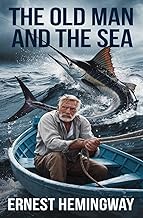
How to Read Ernest Hemingway's Books on Classic literature
How to Read Ernest Hemingway's Books on Classic Literature
Estimated Reading Time: 10-12 minutes
Introduction
Ernest Hemingway, one of the most influential writers of the 20th century, is renowned for his terse prose and profound themes that delve into the human experience. Born in 1899 in Oak Park, Illinois, Hemingway's life was marked by adventure, war, and a relentless pursuit of authenticity, all of which deeply informed his literary works. His unique perspective on Classic literature is not only a reflection of his own tumultuous life but also a critique of the societal norms and existential dilemmas of his time.
Hemingway's works, particularly "The Old Man and the Sea" and "A Farewell to Arms," offer a lens through which we can explore themes of resilience, love, and the human condition. Set against the backdrop of the early 20th century—a time of great upheaval and change—his narratives resonate with timeless relevance, making them essential reads for anyone interested in Classic literature.
Why Ernest Hemingway's Perspective Matters
Hemingway's approach to Classic literature is distinct in its emphasis on simplicity and emotional depth. His "iceberg theory," which suggests that the deeper meaning of a story should not be evident on the surface, invites readers to engage with the text on multiple levels. This technique sets him apart from many contemporaries who favored more elaborate prose and overt symbolism.
Moreover, Hemingway's experiences as a war correspondent and his encounters with various cultures enriched his understanding of human suffering and joy, allowing him to convey complex emotions with remarkable clarity. His works challenge readers to confront the existential questions of life, making his insights both profound and accessible.
Overview of Recommended Books
The Old Man and the Sea
Main Themes and Arguments: "The Old Man and the Sea" tells the story of Santiago, an aging fisherman who struggles against a giant marlin in the Gulf Stream. The novella explores themes of perseverance, dignity, and the relationship between man and nature. Santiago's battle is not just against the fish but also against his own limitations and the inevitability of defeat.
Historical Context and Significance: Published in 1952, this novella emerged during a period when Hemingway's literary reputation was waning. However, it revitalized his career and earned him the Pulitzer Prize for Fiction in 1953. The story reflects post-World War II sentiments, emphasizing the human spirit's resilience in the face of adversity.
Key Insights and Takeaways:
- Perseverance in Adversity: Santiago's relentless struggle against the marlin symbolizes the universal human fight against life's challenges. This theme encourages readers to embrace resilience in their own lives.
- The Nature of Victory and Defeat: The novella illustrates that true victory lies not in triumph but in the courage to fight. Santiago's defeat at the hands of the sharks serves as a reminder that the journey is often more significant than the outcome.
- Connection with Nature: Santiago's deep respect for the marlin highlights the importance of understanding and coexisting with nature, a theme that resonates in today's discussions about environmentalism.
Why Read This Book: "The Old Man and the Sea" is essential for understanding Hemingway's exploration of the human spirit. It appeals to readers seeking inspiration and a deeper connection to nature. Its themes of resilience and dignity are timeless, making it a cornerstone of Classic literature.
A Farewell to Arms
Main Themes and Arguments: "A Farewell to Arms" is a semi-autobiographical novel set during World War I, focusing on the love story between American ambulance driver Frederic Henry and British nurse Catherine Barkley. The novel delves into themes of love, loss, and the brutality of war, portraying the struggle to find meaning amidst chaos.
Historical Context and Significance: Published in 1929, this novel reflects Hemingway's own experiences in the war, capturing the disillusionment felt by many soldiers. It is considered one of the greatest war novels of the 20th century, offering a stark portrayal of the impact of war on human relationships.
Key Insights and Takeaways:
- The Illusion of Romance in War: The novel critiques the romanticism often associated with war, revealing its harsh realities and the emotional toll it takes on individuals.
- The Search for Meaning: Frederic's journey illustrates the struggle to find purpose in a world marked by suffering and uncertainty, a theme that resonates with existential philosophy.
- The Complexity of Love: The relationship between Frederic and Catherine highlights the fragility of love in times of crisis, emphasizing that genuine connections can be both a source of strength and vulnerability.
Why Read This Book: "A Farewell to Arms" is crucial for understanding the complexities of love and loss against the backdrop of war. It appeals to readers interested in the emotional depths of human relationships and the philosophical questions surrounding existence. Its exploration of love amidst chaos makes it a profound contribution to Classic literature.
How These Books Complement Each Other
While "The Old Man and the Sea" and "A Farewell to Arms" tackle different subjects, they share common themes of resilience and the human condition. Both works explore the struggle against insurmountable odds, whether it be Santiago's battle with the marlin or Frederic's fight for love in a war-torn world. Together, they provide a comprehensive understanding of Hemingway's perspective on life, emphasizing the importance of perseverance, love, and the search for meaning.
Who Would Benefit from Reading These Books
These books are ideal for a diverse audience:
- Students and Academics: Those studying literature will find rich themes and stylistic innovations to analyze.
- General Readers Interested in Classic Literature: Anyone seeking a deeper understanding of the human experience will resonate with Hemingway's insights.
- Professionals Seeking Practical Wisdom: The themes of resilience and the search for meaning can provide valuable life lessons.
- Anyone Looking for Personal Growth and Self-Improvement: Readers seeking inspiration and motivation will find encouragement in Hemingway's narratives.
Recommended Reading Order
- Start with: The Old Man and the Sea - This novella's concise narrative and profound themes make it an accessible entry point into Hemingway's work.
- Continue with: A Farewell to Arms - This novel offers a more complex exploration of love and war, building on the themes introduced in the first book.
- Advanced reading: Explore Hemingway's short stories or other novels, such as For Whom the Bell Tolls, to gain a broader understanding of his literary contributions.
Tips for Getting the Most Out of Each Book:
- Take notes on key themes and personal reflections as you read.
- Discuss the books with others to gain different perspectives.
- Consider the historical context and how it influences the narratives.
Conclusion
Ernest Hemingway's contributions to Classic literature are both profound and timeless. His exploration of the human spirit through themes of resilience, love, and the search for meaning continues to resonate with readers today. By engaging with works like "The Old Man and the Sea" and "A Farewell to Arms," readers can gain valuable insights into the complexities of life and the enduring power of the human experience. I encourage you to dive into these masterpieces and discover the wisdom they hold, as they remain relevant in our ever-changing world.
Tags: #Ernest Hemingway #Classic literature #Philosophy #ReadingGuide #ClassicLiterature #Wisdom
Featured Books

The Old Man and the Sea
by Ernest Hemingway
Published: 1952
The Old Man and the Sea is a melodramatic account of an aged fisherman called Santiago and his battles with nature's forces and human limitations. He had been going through weeks without any catch and now ventures out alone in the Gulf Stream.There, he engages in a monstrous battle with a marlin; hence, the story shows a lot of resilience, dignity, and tenacity in adversity. Through Santiago, Hemingway contemplates the magnitude of man's closeness to nature, in both the tragedy and beauty present in life. Read more

A Farewell to Arms
by Ernest Hemingway
Published: 1929
A farewell to Arms is a powerful novel by Ernest Hemingway, set against the backdrop of World War I. The story follows Lieutenant Frederick Henry, an American serving as an ambulance driver in an American Italian Army. Between the bloodshed and anarchy of the war, he meets in love with a British nurse Catherine Barclay and meets deeply.Their romance provides a brief refuge with the horrors around them, but as the war intensifies, frideric violence and insensitive loss are disillusioned. After being injured and returning to the fore, he eventually leaves the army, and the couple participate in Switzerland and ask for peace and a new life.Hemingway's simple, direct prose captures the cruelty of war and deep emotional conflicts of their characters. The subject of discovery of meaning in the world suffering from love, sacrifice, luck, and in the entire novel. With its tragic end and raw honesty, a farewell to weapons is one of the greatest works of the 20th century literature. Read more